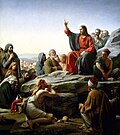| Part of a series on |
| Jewish Christianity |
|---|
 |
The brothers of Jesus or the adelphoi (‹See Tfd›Greek: ἀδελφοί, translit. adelphoí, lit. "of the same womb, brothers")[1][a] are named in the New Testament as James, Joses (a form of Joseph), Simon, Jude,[2] and unnamed sisters are mentioned in Mark and Matthew.[3] They may have been: (1) sons of Mary, the mother of Jesus, and Joseph; (2) sons of Joseph by a former marriage; or (3) sons of Mary of Clopas, named in Mark 15:40 as the "mother of James and Joses", who has been identified as either the sister of Mary, the mother of Jesus, or a sister-in-law to Joseph. [4][b]
Those who uphold the perpetual virginity of Mary reject the idea of biological brethren and maintain that the brothers and sisters were either cousins of Jesus (option 3, the position of the Catholic Church) or children of Joseph from a previous marriage (option 2, the Eastern Orthodox Churches).[4] Some Lutheran Churches have accepted both option 2 and option 3 as being valid explanations for the doctrine of the perpetual virginity of Mary.[5][6]
- ^
- Bateman 2014: "The Greek word here, adelphoi, literally means 'from the same womb,'"
- Verbrugge 2017, p. 15: "one out of the [same] womb"
- Curi 2020: "adelphoi, fratteli, fra coloro dunque che, letteralmente, provengono dallo stesso delphys, escono dallo stesso 'uttero'."
- Segal 1999, p. 184: "For brothers related by blood Greek then develops a new term, adelphos, "of the same womb" (a-delphys), which denotes kinship through the mother.97"
- Holman Bible Publishers et al. 2010: "Brothers (Gk adelphoi; vv. 9,14,17; 3:7; 4:1,10; 5:1,4,12,26) literally means 'from the same womb.'"
- Dozier & Adams 1993, p. 4: "literally 'from the womb' and originally meant from the same womb."
- Silver 1914, p. 272: "In the New Testament the Greek word ἀδελφοί (adelphoi) , rendered "brethren," is the plural form of ἀδελφός (adelphos) which means, literally, 'of the same womb, a brother, relative"
- Levine 2022: "the Greek term adelphoi, literally 'brothers,'"
- ^ Cross & Livingstone 2005, p. 237.
- ^ Bauckham 2015, p. 8.
- ^ a b Cross & Livingstone 2005, p. 237-238.
- ^ Futrell, Rich (27 April 2013). "What are We to Make of the Perpetual Virginity of Mary?". Shepherd of the Hills Lutheran Church. Retrieved 18 September 2023.
- ^ Cite error: The named reference
Erasmus1998was invoked but never defined (see the help page).
Cite error: There are <ref group=lower-alpha> tags or {{efn}} templates on this page, but the references will not show without a {{reflist|group=lower-alpha}} template or {{notelist}} template (see the help page).